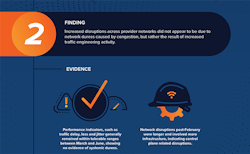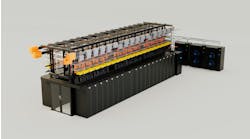DataBytes: Internet Uptime Holds Firm During the Pandemic
Data Bytes is a weekly roundup of research and analysis for the data center and cloud computing sector. Want to get it in your Inbox every Monday? Sign up for our DCF news updates.
The Internet performed just fine during the early months of the COVID-19 pandemic, with outage monitoring showing “little evidence of systemic network duress, even when traffic shifts and volumes were at their peak,” according to network intelligence firm ThousandEyes.
The biggest challenge was not the large spike in network traffic as the pandemic prompted stay-at-home orders and social distancing policies, generating a surge in remote work and media consumption. Instead, the primary reliability challenges were network tweaks as service providers added capacity and flexibility to their networks.
“An initially concerning rise in network disruptions post-pandemic (~63% increase post-February) was found, upon closer inspection, to have the hallmarks of traffic engineering activity, which reportedly increased amongst providers in order to meet changing service demands,” wrote Angelique Medina on the ThousandEyes blog. “In most regions, however, network disruptions are now at, or near, pre-pandemic levels, suggesting that the temporary increase was the result of a necessary adaptation by providers, enabling them to successfully scale capacity and demonstrate their operational agility to meet unforeseen conditions.
“Despite early fear and speculation immediately following pandemic-related lockdowns, the state of the Internet was and remains healthy, with our network measurements (taken via active probing) showing little evidence of systemic network duress, even when traffic shifts and volumes were at their peak. With few exceptions, Internet-related infrastructures over the last six months have held up well.”
Cloud computing providers were strong performers on uptime. Between January and July 2020, cloud providers had about 400 outages, versus more than 4,500 in ISP networks (excluding China). “The purpose-built, software-defined networks employed by the cloud providers may be at least one of the reasons behind this resiliency advantage,” ThousandEyes reported.
“CDN and managed DNS providers experienced few network-related disruptions during the first half of 2020, and when they did occur, within CDN providers specifically, their pattern suggested maintenance events or automation-gone-awry, rather than a systemic performance issue (e.g. network congestion),” the report noted. “For public DNS services, fluctuating patterns of longer and shorter resolution times between weekdays and weekends, appeared to be related to changing usage due to workers moving from offices to the home environment. Overall, however, it’s important to note that DNS providers performed consistently, with response times staying within reasonable limits for reliable user experience. As is the case with the CDN providers, managed DNS providers experienced few outages within their networks.”
ThousandEyes, which recently became part of Cisco, has published an infographic summarizing its findings.
Note: The study was published prior to Sunday’s major outage at CenturyLink/Level 3. For more on that event, see an analysis from CloudFlare and news coverage at The Register and ZDNet. The ThousandEyes team will discuss the CenturyLink outage on the upcoming edition of The Internet Report podcast, which is a useful resource if you’re interested in outages and uptime.






